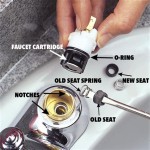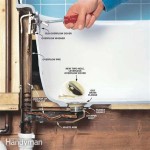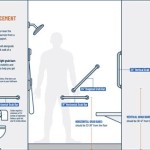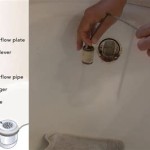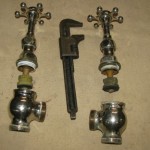How To Make A Straight Back Bathtub Comfortable
Many older homes, and even some newer constructions prioritizing space efficiency, feature bathtubs with straight backs. While functional for bathing, these tubs often lack the ergonomic curves found in modern designs, leading to discomfort during extended soaks. The rigid, upright angle can strain the neck, back, and shoulders, diminishing the relaxation one seeks in a bath. Fortunately, there are several methods to enhance the comfort of a straight back bathtub, transforming it from a purely utilitarian fixture into a more enjoyable and therapeutic space.
The primary focus of improving comfort in a straight back tub lies in providing adequate support and cushioning for the body. This involves strategically utilizing accessories, adjusting water temperature, and considering modifications to the existing bathtub structure, if feasible. The goal is to redistribute pressure points and encourage a more relaxed posture during bathing.
Utilizing Bath Pillows and Cushions
One of the most straightforward and effective ways to enhance comfort in a straight back bathtub is by using bath pillows and cushions. These accessories provide targeted support for the neck, back, and lumbar region, mitigating the strain caused by the tub’s rigid angle. The market offers a diverse range of bath pillows and cushions, each designed with specific features and materials to cater to individual needs and preferences.
Neck Pillows: Neck pillows are specifically designed to cradle the head and neck, preventing them from straining against the hard surface of the tub. They come in various shapes and sizes, including contoured designs that conform to the natural curvature of the neck. Materials commonly used in neck pillows include memory foam, gel, and inflatable vinyl. Memory foam pillows offer excellent support and pressure relief, while gel pillows provide a cooling sensation that can be particularly refreshing. Inflatable pillows are lightweight and easy to store, making them suitable for travel or for those with limited storage space.
Back Cushions: Back cushions provide support for the entire back, helping to maintain a comfortable and upright posture. These cushions are typically larger than neck pillows and often feature textured surfaces to prevent slipping. Look for cushions with adjustable straps or suction cups to secure them firmly to the bathtub wall. Materials like plush terry cloth, waterproof fabric, and memory foam are commonly used in back cushions, offering a combination of comfort and durability.
Lumbar Support Cushions: Lumbar support cushions are designed to target the lower back, providing essential support to the lumbar region. This area is particularly susceptible to strain when sitting in a straight back bathtub. Lumbar cushions often feature a curved or contoured shape that conforms to the natural curve of the lower spine, promoting proper alignment and reducing discomfort. Choosing a cushion made from a firm, supportive material is crucial for effective lumbar support.
When selecting bath pillows and cushions, consider the following factors: the size and shape of the tub, the desired level of support, the materials used, and the ease of cleaning and maintenance. Opting for waterproof and mildew-resistant materials is essential to prevent mold growth and extend the lifespan of the accessories. Properly cleaning and storing the pillows and cushions after each use will further maintain their hygiene and longevity.
Optimizing Water Temperature and Bath Additives
Beyond physical support, the water temperature and bath additives significantly impact the overall comfort and relaxation experienced in a bath. Maintaining an optimal water temperature and incorporating therapeutic bath products can alleviate muscle tension, promote circulation, and create a more soothing and enjoyable bathing experience.
Water Temperature: The ideal water temperature for a bath is typically between 92°F and 100°F (33°C and 38°C). Water that is too hot can cause skin irritation, dehydration, and even burns. Conversely, water that is too cold can constrict blood vessels and hinder relaxation. Use a bath thermometer to accurately gauge the water temperature and adjust it accordingly. Adding warm water gradually as the bath cools down can help maintain the desired temperature for longer soaks.
Bath Salts: Bath salts, such as Epsom salts and Dead Sea salts, are rich in minerals that can provide therapeutic benefits. Epsom salts contain magnesium sulfate, which is known to relieve muscle aches, reduce inflammation, and promote relaxation. Dead Sea salts contain a high concentration of minerals like magnesium, calcium, and potassium, which can help improve skin hydration, reduce stress, and alleviate skin conditions like eczema and psoriasis. Add a cup or two of bath salts to the water and allow them to dissolve completely before entering the tub.
Essential Oils: Essential oils can enhance the bathing experience with their aromatic and therapeutic properties. Lavender oil is known for its calming and relaxing effects, while eucalyptus oil can help clear congestion and relieve respiratory discomfort. Peppermint oil can provide a refreshing and invigorating sensation, while chamomile oil can soothe irritated skin and promote sleep. Add a few drops of essential oil to the bathwater, or dilute them with a carrier oil like jojoba oil or almond oil before adding them to the tub. Always exercise caution when using essential oils, as some may cause skin irritation or allergic reactions. Perform a patch test on a small area of skin before using them in the bath.
Bath Bombs: Bath bombs are pre-packaged balls of dried ingredients that fizz and dissolve in the bathwater, releasing fragrances, colors, and moisturizing oils. They often contain ingredients like baking soda, citric acid, essential oils, and Epsom salts, providing a combination of therapeutic and sensory benefits. Choose bath bombs with natural and skin-friendly ingredients, avoiding those that contain harsh chemicals or artificial dyes. Be mindful of the potential for staining the bathtub with highly pigmented bath bombs.
By carefully controlling the water temperature and incorporating therapeutic bath additives, one can create a more relaxing and rejuvenating bathing experience, effectively mitigating the discomfort associated with a straight back bathtub.
Considering Structural Modifications (If Feasible)
While bath pillows, cushions, and bath additives offer effective and accessible solutions for improving comfort in a straight back bathtub, some individuals may seek more permanent and customized solutions. In such cases, exploring structural modifications to the bathtub or its surroundings may be considered, provided that they are feasible and adhere to building codes and safety regulations. These modifications often require professional expertise and may involve significant investment.
Adding a Sloping Backrest: One relatively straightforward modification involves adding a sloping backrest to the existing bathtub. This can be achieved by installing a removable or permanently attached backrest made from materials like waterproof wood, acrylic, or fiberglass. The backrest should be designed to provide a comfortable angle of recline, reducing the strain on the neck and back. Ensure that the backrest is securely attached to the bathtub wall and that it is waterproof and easy to clean.
Installing a Bathtub Overlay: A bathtub overlay is a custom-fitted acrylic or fiberglass shell that is installed over the existing bathtub. Overlays can be designed with integrated backrests, armrests, and other ergonomic features, effectively transforming the straight back bathtub into a more comfortable and modern design. This option is particularly appealing for those who want to update the aesthetics of their bathroom while also improving the comfort of their bathtub. The installation of a bathtub overlay typically requires professional expertise and may involve a significant investment.
Adjusting Plumbing and Fixtures: Repositioning the bathtub faucets and showerhead can also improve comfort, particularly if they are currently located in inconvenient or uncomfortable positions. Moving the faucets to a more accessible location can reduce the need to strain or reach while filling the tub. Installing an adjustable showerhead allows for greater control over the water flow and direction, ensuring that the water hits the body at the desired angle. These modifications may require the involvement of a licensed plumber.
Creating a Comfortable Surround: Enhancing the area around the bathtub with comfortable seating, soft lighting, and soothing décor can significantly contribute to the overall bathing experience. Adding a small bench or stool near the tub allows for easy access and egress. Installing dimmable lights creates a relaxed and calming atmosphere. Surrounding the tub with plants, candles, or other decorative elements can further enhance the sense of tranquility and relaxation.
Before undertaking any structural modifications, it is crucial to consult with a qualified contractor or bathroom remodeling professional to assess the feasibility, cost, and potential impact on the overall bathroom design and functionality. Ensure that all modifications comply with local building codes and safety regulations.
By employing a combination of these strategies – utilizing bath pillows and cushions, optimizing water temperature and bath additives, and considering structural modifications when feasible – individuals can significantly enhance the comfort of a straight back bathtub. These enhancements facilitate a more relaxing and enjoyable bathing experience, transforming a potentially uncomfortable fixture into a personal oasis of tranquility.

What Is The Most Comfortable Bath Shape Victoriaplum Com

What Is The Most Comfortable Bath Shape Victoriaplum Com

What Is The Most Comfortable Bath Shape Victoriaplum Com
What Is The Most Comfortable Way To Sit In A Bathtub Quora

The Ultimate Guide To Finding Most Comfortable Bathtub For You Kingkonree
Bathroom Design Quick Tip Are Free Standing Tubs Still Popular Designed

Straight Baths Guide Victoriaplum Com

The Best Bath Pillow Options For Comfort In Tub Bob Vila

How Can I Make My Uncomfortable Tub More Relaxing For A Comfy Soak Offbeat Home Life

Acrylic Freestanding Soaking Tubs Innovate Building Solutions
Related Posts

